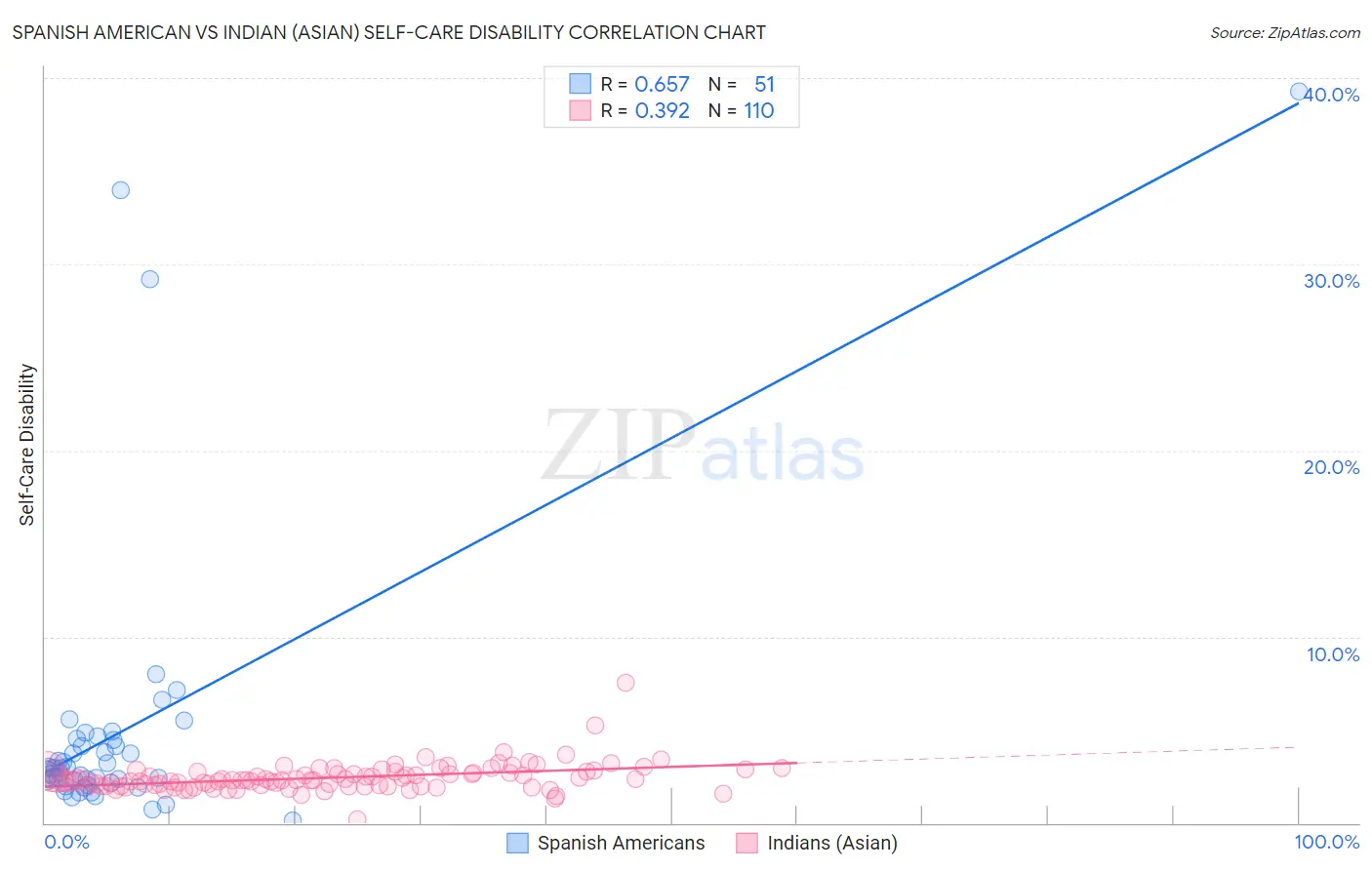Spanish American vs Indian (Asian) Self-Care Disability
COMPARE
Spanish American
Indian (Asian)
Self-Care Disability
Self-Care Disability Comparison
Spanish Americans
Indians (Asian)
2.8%
SELF-CARE DISABILITY
0.0/ 100
METRIC RATING
313th/ 347
METRIC RANK
2.3%
SELF-CARE DISABILITY
98.7/ 100
METRIC RATING
83rd/ 347
METRIC RANK
Spanish American vs Indian (Asian) Self-Care Disability Correlation Chart
The statistical analysis conducted on geographies consisting of 103,142,959 people shows a significant positive correlation between the proportion of Spanish Americans and percentage of population with self-care disability in the United States with a correlation coefficient (R) of 0.657 and weighted average of 2.8%. Similarly, the statistical analysis conducted on geographies consisting of 494,223,906 people shows a mild positive correlation between the proportion of Indians (Asian) and percentage of population with self-care disability in the United States with a correlation coefficient (R) of 0.392 and weighted average of 2.3%, a difference of 20.9%.

Self-Care Disability Correlation Summary
| Measurement | Spanish American | Indian (Asian) |
| Minimum | 0.12% | 0.22% |
| Maximum | 39.3% | 7.5% |
| Range | 39.1% | 7.3% |
| Mean | 4.9% | 2.4% |
| Median | 2.9% | 2.3% |
| Interquartile 25% (IQ1) | 2.2% | 2.0% |
| Interquartile 75% (IQ3) | 4.4% | 2.7% |
| Interquartile Range (IQR) | 2.3% | 0.76% |
| Standard Deviation (Sample) | 7.6% | 0.78% |
| Standard Deviation (Population) | 7.5% | 0.77% |
Similar Demographics by Self-Care Disability
Demographics Similar to Spanish Americans by Self-Care Disability
In terms of self-care disability, the demographic groups most similar to Spanish Americans are Immigrants from Caribbean (2.8%, a difference of 0.030%), Creek (2.8%, a difference of 0.22%), Puget Sound Salish (2.8%, a difference of 0.23%), British West Indian (2.8%, a difference of 0.30%), and Bangladeshi (2.8%, a difference of 0.40%).
| Demographics | Rating | Rank | Self-Care Disability |
| Aleuts | 0.0 /100 | #306 | Tragic 2.8% |
| Natives/Alaskans | 0.0 /100 | #307 | Tragic 2.8% |
| Immigrants | Grenada | 0.0 /100 | #308 | Tragic 2.8% |
| Bangladeshis | 0.0 /100 | #309 | Tragic 2.8% |
| British West Indians | 0.0 /100 | #310 | Tragic 2.8% |
| Puget Sound Salish | 0.0 /100 | #311 | Tragic 2.8% |
| Immigrants | Caribbean | 0.0 /100 | #312 | Tragic 2.8% |
| Spanish Americans | 0.0 /100 | #313 | Tragic 2.8% |
| Creek | 0.0 /100 | #314 | Tragic 2.8% |
| Immigrants | Cuba | 0.0 /100 | #315 | Tragic 2.8% |
| Menominee | 0.0 /100 | #316 | Tragic 2.8% |
| Immigrants | Dominica | 0.0 /100 | #317 | Tragic 2.8% |
| Assyrians/Chaldeans/Syriacs | 0.0 /100 | #318 | Tragic 2.8% |
| Spanish American Indians | 0.0 /100 | #319 | Tragic 2.9% |
| Chickasaw | 0.0 /100 | #320 | Tragic 2.9% |
Demographics Similar to Indians (Asian) by Self-Care Disability
In terms of self-care disability, the demographic groups most similar to Indians (Asian) are Immigrants from Spain (2.3%, a difference of 0.040%), Ugandan (2.3%, a difference of 0.070%), Immigrants from Denmark (2.3%, a difference of 0.070%), Chilean (2.3%, a difference of 0.14%), and Immigrants from Middle Africa (2.3%, a difference of 0.33%).
| Demographics | Rating | Rank | Self-Care Disability |
| Immigrants | China | 99.1 /100 | #76 | Exceptional 2.3% |
| Immigrants | Middle Africa | 99.0 /100 | #77 | Exceptional 2.3% |
| Immigrants | Ireland | 99.0 /100 | #78 | Exceptional 2.3% |
| Immigrants | Kenya | 99.0 /100 | #79 | Exceptional 2.3% |
| Chileans | 98.8 /100 | #80 | Exceptional 2.3% |
| Ugandans | 98.8 /100 | #81 | Exceptional 2.3% |
| Immigrants | Denmark | 98.8 /100 | #82 | Exceptional 2.3% |
| Indians (Asian) | 98.7 /100 | #83 | Exceptional 2.3% |
| Immigrants | Spain | 98.7 /100 | #84 | Exceptional 2.3% |
| Estonians | 98.3 /100 | #85 | Exceptional 2.3% |
| Immigrants | Northern Africa | 98.2 /100 | #86 | Exceptional 2.3% |
| Sierra Leoneans | 98.0 /100 | #87 | Exceptional 2.4% |
| Lithuanians | 98.0 /100 | #88 | Exceptional 2.4% |
| Immigrants | Congo | 98.0 /100 | #89 | Exceptional 2.4% |
| Immigrants | Czechoslovakia | 97.7 /100 | #90 | Exceptional 2.4% |